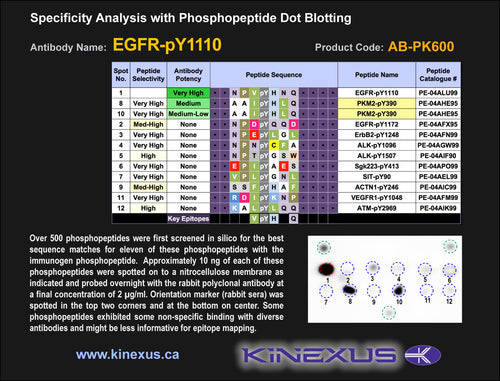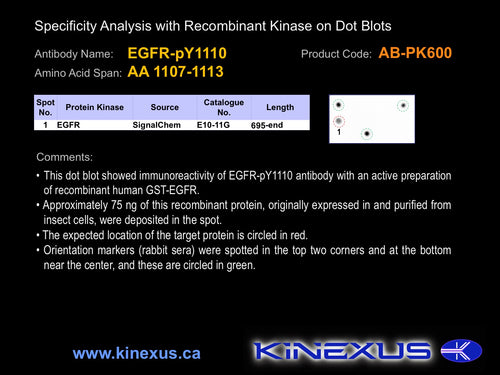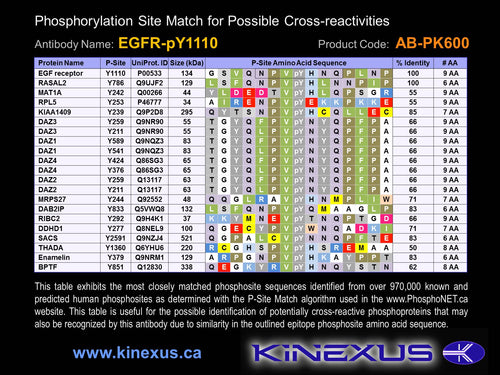Product Name:
DYRK2-pY382
Product Number:
ab-pk600
Target Full Name: Dual specificity tyrosine-phosphorylation-regulated kinase 2
Target Alias: Dual-specificity tyrosine-(Y)-phosphorylation regulated kinase 2; DYRK2; FLJ21217; FLJ21365
Product Type Specific: Protein kinase phosphosite-specific antibody
Antibody Code: PK598
Antibody Target Type: Phosphosite-specific
Antibody Phosphosite: Y382
Protein UniProt: Q92630
Protein SigNET: Q92630
Antibody Type: Polyclonal
Antibody Host Species: Rabbit
Antibody Immunogen Source: Human DYRK2 sequence peptide
Antibody Immunogen Sequence: VYT(pY)IQS(bA)C
Antibody Immunogen Description: Corresponds to amino acid residues V379 to S385; In the protein kinase catalytic domain activation T loop region between subdomains VII and VIII.
Production Method: Corresponds to amino acid residues V379 to S385; In the protein kinase catalytic domain activation T loop region between subdomains VII and VIII.
Antibody Modification: Protein kinase phosphosite-specific antibody
Antibody Concentration: 0.3 / 1.0 mg/ml
Storage Buffer: Phosphate buffered saline pH 7.4, 0.05% Thimerasol
Storage Conditions: For long term storage, keep frozen at -40°C or lower. Stock solution can be kept at +4°C for more than 3 months. Avoid repeated freeze-thaw cycles.
Product Use: Western blotting | Antibody microarray
Antibody Dilution Recommended: 2 µg/ml for immunoblotting
Antibody Species Reactivity: Human
Antibody Positive Control: The observed molecular mass of the processed target protein on SDS-PAGE gels is reported to be around 60-70 kDa.
Antibody Specificity: Very high
Antibody Cross Reactivity: No significant cross-reactive proteins detected in HeLa, A431 and MCF7 cells.
Related Product 1: DYRK2-ANT pan-specific antibody (Cat. No.: AB-NK266-1)
Related Product 2: DYRKSubtide - DYRK1A protein kinase substrate peptide
Scientific Background: DYRK2 is a protein-serine/threonine kinase of the CMGC group and DYRK family. It is a dual-specificity protein kinase that regulates cell cycle progression, cell proliferation, apoptosis, cytoskeletal organization, and neurite outgrowth. DYRK2 functions downstream of ATM and directly phosphorylates p53/T53 at the S46 to promotion of apoptosis in the presence of DNA damage. In addition, DYRK2 functions in ubiquitin-dependent proteasomal protein degradation, specifically promoting the degradation of the oncoproteins in the Myc and Jun families. DYRK2 appears to be a tumour suppressor protein (TSP). Abnormal expression of DYRK2 have been associated with various forms of human cancer. In breast cancer cells, DYRK2 negatively regulates the stability of Snail, a transcription factor that regulates the epithelial-mesenchymal transistion (EMT). Knock-down of DYRK2 expression in breast cancer cells promotes EMT and tumour invasion both in vitro and in vivo. In addition, tumours with low expression of DYRK2 were correlated with a significantly lower patient survival and higher metastasis rate than tumours with high DYRK2 expression. Therefore, the DYRK2 protein appears to be a critical suppressor of cancer invasion and metastasis. Similarly, the 5-year survival rates of pulmonary adenocarcinoma patients was significant higher for those with DYRK2-positive tumours (89. 2%) than those with DYRK2-negative tumours (66. 3%), indicating a critical role for DYRK2 as a tumour suppressor in this cancer type as well.




